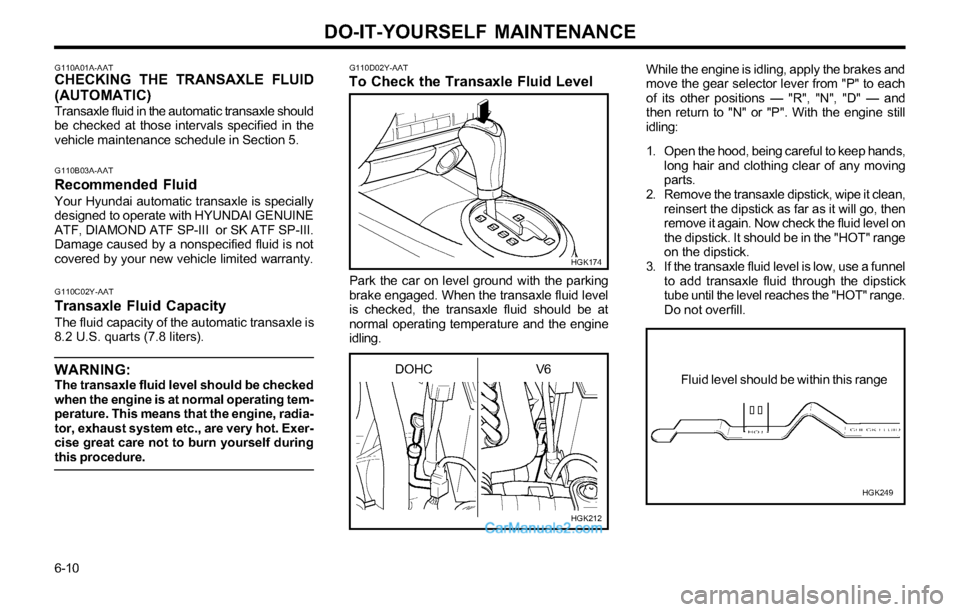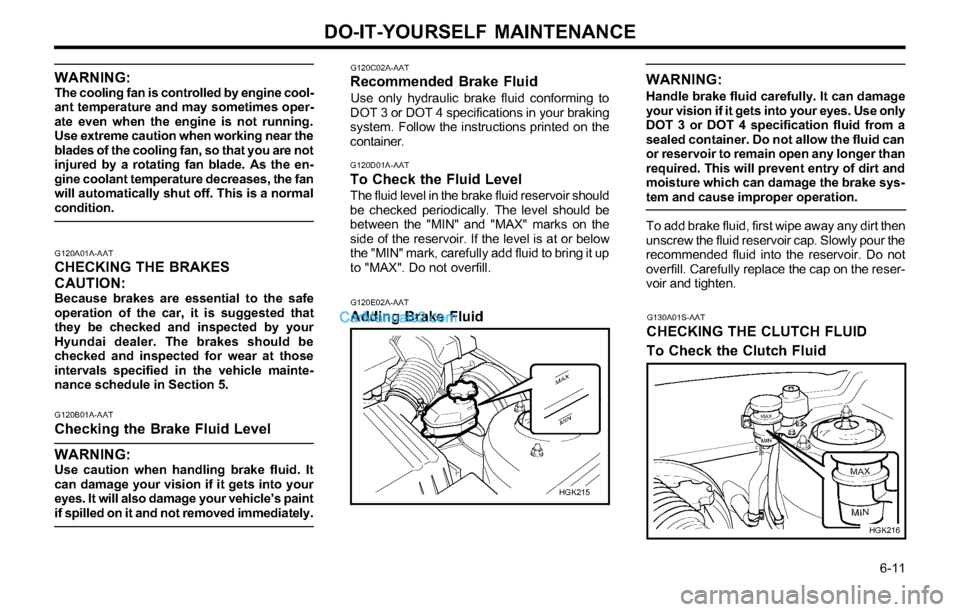2003 Hyundai Tiburon maintenance schedule
[x] Cancel search: maintenance schedulePage 140 of 169

DO-IT-YOURSELF MAINTENANCE
6-9
G100B01A-AATTo Check the Manual Transaxle
Fluid Level
SSA6100B
Park the car on level ground with the engine off.
1. Using a wrench of the correct size, loosen
the oil filler plug by turning it counterclock-
wise and remove it with your fingers.
2. Use your finger or suitable tool to feel inside
the hole. The oil level should be at its bottom
edge. If it is not, check for leaks before
adding oil. To refill the transaxle or bring the
oil level up,add oil slowly until it reaches the
proper level. Do not overfill.
3. Replace the plug, screw it in with your fin-
gers and then tighten securely with the
wrench.
G090A01A-AATFILLING THE WASHER RESERVOIR
The washer fluid reservoir supplies fluid to the
windshield washer system.
A good quality washer fluid should be used to fill
the washer reservoir. The fluid level should be
checked more frequently during bad weather or
whenever the washer system is in more fre-
quent use.
The capacity of the washer reservoir is 3.2 U.S.
quarts (3.0 Liters).
CAUTION:o Radiator anti-freeze (engine coolant)
should not be used in the washer system
because it will damage the car’s finish.
o The washer lever should not be pulled
and the washer should not be operated
if the washer reservoir is empty. This can
damage the washer fluid pump.
Transaxle lubricant in the manual transaxle should
be checked at those intervals specified in the
vehicle maintenance schedule in Section 5.
Recommended OilUse only HYUNDAI GENUINE PARTS MTF
75W/90 (API GL-4) or equivalents in the manual
transaxle.
Manual Transaxle Oil CapacityThe oil capacity of the manual transaxle:
2.3 us quarts (2.15L)
WARNING:It is always better to check the transaxle oil
level when the engine is cool or cold. If the
engine is hot, you should exercise great
caution to avoid burning yourself on hot
engine or exhaust parts.
G100A02GK-AATCHECKING THE TRANSAXLE OIL
(MANUAL)
G110A01E
Filler plug
Drain plugHGK217
Page 141 of 169

DO-IT-YOURSELF MAINTENANCE
6-10
While the engine is idling, apply the brakes and
move the gear selector lever from "P" to each
of its other positions — "R", "N", "D" — and
then return to "N" or "P". With the engine still
idling:
1. Open the hood, being careful to keep hands,
long hair and clothing clear of any moving
parts.
2. Remove the transaxle dipstick, wipe it clean,
reinsert the dipstick as far as it will go, then
remove it again. Now check the fluid level on
the dipstick. It should be in the "HOT" range
on the dipstick.
3. If the transaxle fluid level is low, use a funnel
to add transaxle fluid through the dipstick
tube until the level reaches the "HOT" range.
Do not overfill.G110A01A-AATCHECKING THE TRANSAXLE FLUID
(AUTOMATIC)
Transaxle fluid in the automatic transaxle should
be checked at those intervals specified in the
vehicle maintenance schedule in Section 5.
G110B03A-AATRecommended Fluid
Your Hyundai automatic transaxle is specially
designed to operate with HYUNDAI GENUINE
ATF, DIAMOND ATF SP-III or SK ATF SP-III.
Damage caused by a nonspecified fluid is not
covered by your new vehicle limited warranty.
G110C02Y-AATTransaxle Fluid Capacity
The fluid capacity of the automatic transaxle is
8.2 U.S. quarts (7.8 liters).
WARNING:The transaxle fluid level should be checked
when the engine is at normal operating tem-
perature. This means that the engine, radia-
tor, exhaust system etc., are very hot. Exer-
cise great care not to burn yourself during
this procedure.DOHC V6
HGK212 G110D02Y-AAT
To Check the Transaxle Fluid Level
HGK174
Park the car on level ground with the parking
brake engaged. When the transaxle fluid level
is checked, the transaxle fluid should be at
normal operating temperature and the engine
idling.
Fluid level should be within this range
HGK249
��
Page 142 of 169

DO-IT-YOURSELF MAINTENANCE
6-11
G120C02A-AATRecommended Brake Fluid
Use only hydraulic brake fluid conforming to
DOT 3 or DOT 4 specifications in your braking
system. Follow the instructions printed on the
container.
G120D01A-AAT
To Check the Fluid LevelThe fluid level in the brake fluid reservoir should
be checked periodically. The level should be
between the "MIN" and "MAX" marks on the
side of the reservoir. If the level is at or below
the "MIN" mark, carefully add fluid to bring it up
to "MAX". Do not overfill.
G120E02A-AAT
Adding Brake FluidWARNING:
Handle brake fluid carefully. It can damage
your vision if it gets into your eyes. Use only
DOT 3 or DOT 4 specification fluid from a
sealed container. Do not allow the fluid can
or reservoir to remain open any longer than
required. This will prevent entry of dirt and
moisture which can damage the brake sys-
tem and cause improper operation.
To add brake fluid, first wipe away any dirt then
unscrew the fluid reservoir cap. Slowly pour the
recommended fluid into the reservoir. Do not
overfill. Carefully replace the cap on the reser-
voir and tighten.
G130A01S-AAT
CHECKING THE CLUTCH FLUID
To Check the Clutch Fluid
HGK215
HGK216
G120A01A-AATCHECKING THE BRAKES
CAUTION:
Because brakes are essential to the safe
operation of the car, it is suggested that
they be checked and inspected by your
Hyundai dealer. The brakes should be
checked and inspected for wear at those
intervals specified in the vehicle mainte-
nance schedule in Section 5.
G120B01A-AAT
Checking the Brake Fluid Level
WARNING:
Use caution when handling brake fluid. It
can damage your vision if it gets into your
eyes. It will also damage your vehicle’s paint
if spilled on it and not removed immediately.
WARNING:The cooling fan is controlled by engine cool-
ant temperature and may sometimes oper-
ate even when the engine is not running.
Use extreme caution when working near the
blades of the cooling fan, so that you are not
injured by a rotating fan blade. As the en-
gine coolant temperature decreases, the fan
will automatically shut off. This is a normal
condition.
Page 153 of 169

EMISSION CONTROL SYSTEMS
7-1
7. EMISSION CON-
TROL SYSTEMSH010B01A-AAT1. Crankcase Emission Control
System
The Positive Crankcase Ventilation System is
employed to prevent air pollution caused by
blow-by gases being emitted from the crank-
case. This system supplies fresh filtered air to
the crankcase through the air intake hose.
Inside the crankcase, the fresh air mixes with
blow-by gases, which then pass through the
PCV valve and into the induction system.
H010C01S-AAT2. Evaporative Emission Control (In-
cluding ORVR: Onboard Refueling
Vapor Recovery) System
The Evaporative Emission Control System is
designed to prevent fuel vapors from escaping
into the atmosphere.
(The ORVR system is designed to allow the
vapors from the fuel tank to be loaded into
a canister while refueling at the gas station,
preventing the escape of fuel vapors into
the atmosphere.)
Canister
Fuel vapors generated inside the fuel tank are
absorbed and stored in the onboard canister.
When the engine is running, the fuel vapors
absorbed in the canister are drawn into the
induction system through the purge control so-
lenoid valve.
Purge Control Solenoid Valve (PCSV)
The purge control solenoid valve is controlled
by the Engine Control Module (ECM); when the
engine coolant temperature is low during idling,
the PCSV closes so that evaporated fuel is not
taken into the engine. After the engine warms-
up during ordinary driving, the PCSV opens to
introduce evaporated fuel to the engine.
H010D01A-AAT
3. Exhaust Emission Control System
The Exhaust Emission Control System is a
highly effective system which controls exhaust
emissions while maintaining good vehicle per-
formance.
H010A01GK-AAT
EMISSION CONTROL SYSTEM
Your Hyundai is equipped with an emission
control system to meet all requirements of the
U.S. Environmental Protection Agency or Cali-
fornia Air Resources Board.
There are three emission control systems which
are as follows.
1) Crankcase Emission Control System
2) Evaporative Emission Control System
3) Exhaust Emission Control System
In order to ensure the proper function of the
emission control systems, it is recommended
that you have your car inspected and main-
tained by an authorized Hyundai dealer in ac-
cordance with the maintenance schedule in this
manual.
Caution for Inspection and Maintenance Test
(Vehicle with Traction Control System)
o To prevent the vehicle from misfiring
during dynamometer testing, disconnect
the ABS connector located inside of the
wheel guard (driver side).
o For more information, see shop manual
(BR Group, Wheel Speed Sensor).
H020A01S-AAT
CATALYTIC CONVERTER
Catalytic Converter
(California)
SSA7020A
Catalytic Converter
(Federal, California)
7
Page 166 of 169

INDEX
10-3 S
Seat Belts
3-Point system ................................................................................. 1-12
Adjustable height .............................................................................. 1-11
Adjusting your seat belt ................................................................... 1-13
Care of seat belts ............................................................................. 1-11
Precautions ...................................................................................... 1-10
Spark Plugs ........................................................................................... 6-6
Spectacle Case .................................................................................... 1-36
Speedometer ...........................................................................................1-29
Starting Procedures ............................................................................... 2-3
Steering Wheel
Free play ............................................................................................6-13
Tilt lever ..............................................................................................1-43
Stereo Radio Operation (H250, H260, H280) .................. 1-61, 1-68, 1-75
Stereo Sound System .......................................................................... 1-59
Sun Visor ............................................................................................. 1-42
Sunroof .................................................................................................. 1-35
T
Tachometer ......................................................................................... 1-29
Tail Gate ............................................................................................... 1-41
Tailgate Wiper and Washer Switch ...................................................... 1-32
Theft-alarm System ................................................................................ 1-4
Tires
Balancing ........................................................................................... 8-3
Chains ................................................................................................ 8-2
Changing a flat tire ............................................................................. 3-4
If you have a flat tire .......................................................................... 3-4
Information ......................................................................................... 8-1
Pressure ............................................................................................. 8-1
Replacement ..................................................................................... 8-3
Rotation ............................................................................................. 8-2 K
Keys ....................................................................................................... 1-2
If you lose your keys ......................................................................... 3-9
Positions ............................................................................................ 2-2
L
Luggage net ......................................................................................... 1-43
M
Maintenance Intervals
Explanation of scheduled maintenance items ......................... 5-6 ~ 5-7
Maintenance under severe usage conditions ................................... 5-5
Scheduled maintenance ........................................................... 5-3 ~ 5-4
Service requirements ......................................................................... 5-1
Map Light .............................................................................................. 1-36
Mirror
Day-night inside rearview ................................................................. 1-38
Outside rear view ............................................................................. 1-37
O
Odometer ............................................................................................. 1-29
P
Parking Brake ...................................................................................... 1-39
Power Steering Fluid Level ................................................................... 6-16
Pre-tensioner Seat Belt ............................................................. 1-17 ~ 1-18
R
Radio (H250, H260, H280) ................................................ 1-61, 1-68, 1-75
Rear Seats
Before folding the rear seats .............................................................. 1-9
Fold down ........................................................................................... 1-9
Rear seat entry ................................................................................. 1-9
Rear seat positions ............................................................................ 1-8
Rear Window Defroster Switch ............................................................ 1-33
Page 169 of 169

Seoul Korea
Printing: AUG. 30, 2002
Publication No.: A2CO-EU28E
Printed in Korea
SERVICE STATION INFORMATION
FUEL:
UNLEADED gasoline only
Pump Octane Rating of 87 (Research Octane Number 91) or higher.
FUEL TANK CAPACITY
Original, US.gal (Imp.gal., liter) 14.5 (12, 55)
TIRE PRESSURE:
See the label on the driver side center pillar outer panel.
OTHER TIRE INFORMATION:
See pages 8-1 through 8-4
HOOD RELEASE:
Pull handle under left side of dash.
ENGINE OIL:
SH, SG or SG/CD multigrade and fuel efficient oil. Use SAE 10W-30,
10W-40 or 10W-50 if normal temperatures are above -10°F (-23°C).
For other viscosity recommendations, see page 6-2.
MANUAL TRANSAXLE:
HYUNDAI GENUINE PARTS MTF 75W/90 (API GL-4) Oil level
should be up to filler-bolt hole in housing beside differential.
AUTOMATIC TRANSAXLE:
Apply the parking brake, with the engine running, shift the selector
lever through all ranges and return to “N” (Neutral) position. Then
check the level of fluid on the dipstick. Use only HYUNDAI GENU-
INE ATF available at your dealer or DIAMOND ATF SP-III, SK ATF
SP-III.
QUICK INDEX
o Car will not start ........................................................................ 3-1
o Flat tire ...................................................................................... 3-4
o Warning light/chime comes on ...................................... 1-26 ~ 1-28
o Engine overheats ....................................................................... 3-2
o Towing of your vehicle ............................................................. 3-8
o Starting the engine ..................................................................... 2-3
o Driving tips for first 1,200 miles (2,000 km) ............................ 1-2
o Scheduled maintenance ............................................................. 5-3
o Reporting safety defects ............................................................ 8-6